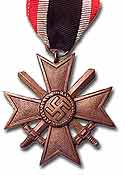
Courtesy of Karl-Heinz Euling
SS-Hauptsturmführer
Karl-Heinz Euling
I./SS-Pz.Gren.Rgt.22
10.SS-Pz.Div. "Frundsberg"
II.SS-Pz.Armeekorps
Träger des Ritterkreuz des Eiserne Kreuze (no.3892)

Courtesy of Karl-Heinz Euling






Karl-Heinz Euling was born on 16 August 1919 in Dorndorf, in the Thürischen region of Eisenach. On 22 March 1932, Karl-Heinz joined the Hitler Youth where he earned the HJ-Leistungsabzeichen (proficiency clasp) and the golden HJ-Ehrenabzeichen (honor clasp). On 1 September 1937 Euling joined the NSDAP. After the Volksschule, Euling attended a reform high school and passed his matriculation examination in February 1938.
Karl-Heinz Euling joined the Waffen-SS on 1 April 1938. His basic training was completed with the 2./SS-Totenkopf-Standarte "Brandenburg" that later participated in the campaign against Poland. After successful completion of the SS-Junkerschule Braunschweig from 1 February - 8 May 1940 and achievements during his service in the SS-Infantrie-Regiment 10, Euling was promotion to SS-Untersturmführer (Lieutenant) on 1 August 1940. After being wounded, Euling was and transferred to the SS-Infanterie-Ersatz-Bataillon "Ost" and on 1 August 1942 to the 1.SS-Infanterie-Brigade. Having served as a platoon commander, ordnance officer and regimental adjutant, Euling earned the Kriegsverdienst Kreuz II. class and I. class with swords, and the Iron Cross II. and I. class. On 9 November 1943, Euling was promoted to SS-Hauptsturmführer (Captain) and transferred to the western front and assigned to the staff of the II.SS-Pz.Korps.
In early 1944, Euling and the II.SS-Pz.A.K. headed eastward to relieve the 1.Panzer-Armee, surrounded by numerically superior Soviet forces at Buczacz. During the Allied landings at Normandy, Euling was transferred to the 10.SS-Pz.Div. "Frundsbrg" and placed in command of I./SS-Pz.Gren.Rgt.21. In the fall of 1944, Euling witnessed the Allied airborne operation "Market Garden." On 27 September 1944, the German Wehrmacht Report stated, On 26 September, the last resistance of the encircled British 1st Airborne Division was broken in the area of Arnheim. During ten days of bitter fighting, the commander of a SS-Panzerkorps, SS-Obergruppenführer and General der Waffen-SS Wilhelm Bittrich, managed organize an adhoc German force and destroy an elite British division that fought hard in the defense and was re-supplied by additional airborne landing. Every Allied attempt to rescue the encircled division resulted in failure and high numbers of casualties. A total of 6450 prisoners were taken and many thousand reported dead. Thirty anti-tank guns, numerous weapons and 250 vehicles were captured. Moreover, over 1000 gliders were either destroyed or captured and over 100 aircraft were shot down. On 19 September 1944, the 25-year old Hauptsturmführer Euling and his battalion (I./22) broke from the bitter house-to-house fighting men held a position in front of the great bridge at Nimwegen that blocked the road leading to Arnheim.

Copyright Stenger
Historica 2004